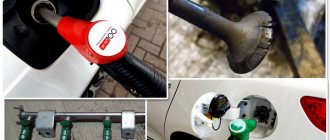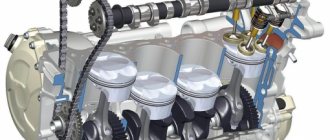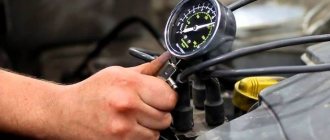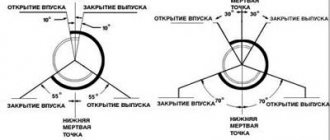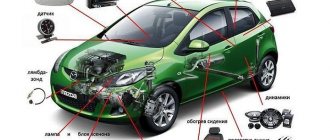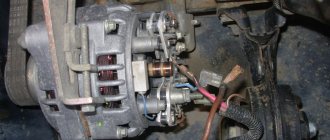Which gasoline to choose AI92 or AI95? This question worries every car owner. If we talk about AVTOVAZ’s new product, the Lada Vesta, it is worth noting that the manufacturer recommends using AI95 gasoline. To save money, many people start using cheaper AI92 fuel. And some, on the contrary, spare no expense and fill the tank with AI98 or AI 98G-drive..
In the operating manual Lada Vesta manufacturer
indicated that only unleaded gasoline “Premium Euro-95 GOST R 51866” or “AI-95-K5 GOST 32513-20013” is allowed for use. If necessary, it is allowed to use gasoline with an octane number of at least 92.
What kind of gasoline should I use?
The Lada Vesta tank must be filled with the type of fuel recommended in the manual that comes with the car. In addition, the type of gasoline is duplicated on the back of the Vesta hatch. According to official information, AI-95 must be filled into the Lada tank - this is due to all its 1.6-liter engines (86 hp, 106 hp, 114 hp).
What kind of gasoline should you fill Vesta with to protect yourself from problems?
In this case, it is highly advisable to do without experimentation, since the power unit is initially configured for a specific type of fuel. When filling the tank with AI-92 gasoline in the Lada Vesta, during dynamic acceleration and heavy loads, the knock sensor will start to work, and this will result in unstable engine operation and loss of speed. In addition, overheating of the motor and its accelerated wear are possible. And the possibility of the cylinder head burning out should not be discounted, as this may result in a major overhaul (replacement of valves, pistons and other components).
Information about the type of fuel is on the back of the Lada Vesta hatch.
Tests "Behind the wheel"
Experts from the magazine “Behind the Wheel” took two editorial Vestas. A sedan with a 1.6‑liter engine and AMT, as well as a SW Cross station wagon with a 1.8‑liter engine and manual transmission. Lukoil Ecto gasoline of different grades was poured into each car in turn: first AI-92, then AI-95, and for dessert - the elite AI-100. The races were carried out at the same time in similar weather. To minimize measurement error, the canisters were filled at the same dispenser (from the corresponding pistols, of course) at the same gas station. Test results:
What kind of gasoline do you recommend for filling the Vesta? Is there a difference when using gasoline with different octane ratings? Take part in the survey and leave your comments. Let us remind you that in another article we determine the real fuel consumption of AVTOVAZ’s new product.
Keywords: power system Lada Vesta | Lada Vesta engine
0 0 0 0 0 0
Share on social networks:
Petrol
According to fuel requirements, the plant allows Vesta to be filled with unleaded gasoline, the octane number of which is at least 92, class 5. In principle, it is not currently sold at other gas stations.
However, mechanics recommend filling in 95-grade gasoline and only at branded gas stations - at 92, VAZ engines are prone to detonation. This, by the way, is confirmed by the manual, which recommends using 95. As for 98 gasoline, this is unjustified and leads to unnecessary waste of money.
During winter operation, you can use an additive such as a fuel dryer; all other additives are unlikely to provide anything useful.
Fuel quality
A preliminary assessment of the quality of gasoline can be given visually - by its color. High-quality AI-95 and AI-95 are almost transparent with a slight yellow or blue tint.
Absolutely transparent, colorless fuel is straight-run gasoline, unsuitable for engines. Fuel with a red tint contains metal-containing additives (manganese, ferrocene), while rich yellow fuel contains monomethylaniline.
If gasoline does not visually cause suspicion, you can refuel.
What kind of gasoline is better to fill in Lada Vesta: theory and practice
Types of engines and their compression ratio
The Vesta sedan was equipped with 4 types of engines:
| Engine brand | Volume | Power | Number of valves | Compression ratio |
| VAZ-11189 | 1.6 l | 86 hp | 8 | 10,3 |
| VAZ-21129 | 1.6 l | 106 hp | 16 | 10,45 |
| VAZ-21176 | 1.8 l | 122 hp | 16 | 10,5 |
| HR16DE-H4M | 1.6 l | 114 hp | 16 | 9.5 (after modification by AvtoVAZ) |
Compression ratio and gasoline grade
The brand of fuel used is “tied” to the “compression ratio” of the internal combustion engine; for clarity, we tabulate the approximate dependence of these characteristics:
| Compression ratio | Fuel |
| 9–10,5 | AI-92 |
| 10–12,5 | AI-95 |
| 12–14,5 | AI-98 |
In the Lada Vesta operating instructions we find a line that is indicated by all car manufacturers in different interpretations.
At the same time, in the Vesta operating instructions, the plant allows the use of gasoline with an octane rating of 92, but recommends the use of AI-95 fuel.
Based on the values of the compression ratio of VAZ engines, this resolution should be rephrased as follows: in normal mode, AI-95 should be used, in gentle mode, AI-92.
AvtoVAZ made changes to the Nissan HR16DE-H4M engine, and its compression ratio was reduced from 10.7 to 9.5.
Let's consider the influence of the octane number of gasoline on engine operation, including the Lada Vesta, and the real factors influencing the ability to comply with the manufacturer's recommendations.
Theoretically, the use of AI-95 adds dynamism to the car (relative to the use of AI-92) and reduces fuel consumption, but the other side of the coin is the higher price of this fuel. And vice versa, the consumption of AI-92 is higher, a car running on this fuel is less playful, but the cost of gasoline is lower.
In fact, the situation is not always like this. The consumption of these two types of fuel in one car depends, in addition to the octane number, on other factors, for example, the quality of the fuel and the individual driving style of the car owner.
Fuel quality
A preliminary assessment of the quality of gasoline can be given visually - by its color. High-quality AI-95 and AI-95 are almost transparent with a slight yellow or blue tint.
Absolutely transparent, colorless fuel is straight-run gasoline, unsuitable for engines. Fuel with a red tint contains metal-containing additives (manganese, ferrocene), while rich yellow fuel contains monomethylaniline.
If gasoline does not visually cause suspicion, you can refuel.
Fuel quality ranges
High-quality fuel with the same octane number from two gas stations may have different effects on the engine. This does not mean that the fuel is bad; the reasons for the difference may be the following:
- GOST requires that the octane number of gasoline, for example, AI-92, be “not less than 92,” and the fuel at one station may have this value of 92.7, at the second - 92.1.
- According to the same requirements, the tar content in gasoline should be “no more than 10.0 mg/100 cm3”, and the proportion of sulfur “no more than 0.1%”, and these indicators can also fit within the norm, but vary in value.
An experienced driver will feel the difference in the quality of gasoline and decide to abandon the AI-95 recommended by the manufacturer. This erroneous decision is supported by the presence of a knock sensor in the internal combustion engine, which, when switching to low-octane fuel, will automatically shift the ignition timing.
The sensor reacts to detonation that has already occurred, rather than preventing it.
In addition, after the knock sensor is triggered, the fuel will burn out in the exhaust manifold or, which is really bad, in the catalyst. That is, in such cases, the engine does not adapt to the fuel, but loses power, dynamics and efficiency, and the sensitivity of the gas pedal decreases.
All this speaks to the extreme inexpediency of long-term use of AI-92 gasoline in VAZ engines instead of the recommended AI-95, only in emergency cases.
Practice of using gasoline AI-92 and AI-95
In practice, circumstances can be very different. In large cities, control over the quality of fuel sold is carried out more effectively than in the outback. At gas stations with difficult-to-remember names, AI-92 gasoline may be preferable to AI-95 , which can be obtained by adding cheap, low-quality additives to cheap gasoline. In such cases, you just have to rely on your driving sensations and the condition of the spark plugs, soot on which, especially red in color, will indicate the presence of harmful substances in the fuel.
Does Vesta need AI-98 gasoline?
Commercial gasoline AI-98 is a fuel obtained by adding to the base of all gasolines - high-octane gasoline - reforming a significant amount of high-quality octane-increasing additives (16%), promoting complete and more uniform combustion of the fuel. The use of high-quality AI-98 in Lada Vesta will not cause any harm to the engine of any Lada model; rather, on the contrary, it will ensure smooth operation of the power unit, an increase in power of 5-10% and even a slight increase in efficiency.
Recommendations for refueling your car
To ensure that the engine of your Lada Vesta is satisfied with the fuel it consumes, follow the following recommendations:
- Do not fill your car with gasoline with an octane rating not recommended by the manufacturer.
- It is better to fill up gasoline at trusted gas stations. This, of course, also does not provide a 100% guarantee, but large gas station chains are more loyal to pre-trial resolution of problems that have arisen.
- From the previous paragraph it follows that you must always save receipts after refueling.
- Try not to leave the fuel tank empty - in this case, condensation will form on the walls, which will then mix with gasoline.
- Change the fuel filter more often than stated in the technical instructions for your car.
Transmission oil
The service book states that after a mileage of 180 thousand km the oil in robotic and manual transmissions needs to be changed, but the experience of Vesta owners suggests that the oil in them should be updated much more often - for every 60 thousand km.
You will need 3 liters of oil of quality class GL-5/GL-4 (according to API) with a viscosity of 75W-80. It’s the same with the variator: although the instructions don’t provide for changing the oil at all, you can extend the service life of the transmission if you change the fluid every 60 thousand. How much liquid is required will be determined by the method by which the change is made, but it is better to stock up on a couple of 4-liter canisters.
Lada Vesta around the city
In urban conditions, I usually get the same fork of 9-9.5 liters, depending on the warm-up. In winter it comes out to 11 liters. Now let's see how much I got now. Here I got 9.7 liters.
That is, if we take everything into account in an amateurish way, I don’t measure exactly how much I put into the tank, but just look at the on-board computer. He calculates and shows everything himself. I also took measurements for 95 gasoline. It can be seen that there is no difference overall.
Fuel quality ranges
High-quality fuel with the same octane number from two gas stations may have different effects on the engine. This does not mean that the fuel is bad; the reasons for the difference may be the following:
- GOST requires that the octane number of gasoline, for example, AI-92, be “not less than 92,” and the fuel at one station may have this value of 92.7, at the second - 92.1.
- According to the same requirements, the tar content in gasoline should be “no more than 10.0 mg/100 cm3”, and the proportion of sulfur “no more than 0.1%”, and these indicators can also fit within the norm, but vary in value.
An experienced driver will feel the difference in the quality of gasoline and decide to abandon the AI-95 recommended by the manufacturer. This erroneous decision is supported by the presence of a knock sensor in the internal combustion engine, which, when switching to low-octane fuel, will automatically shift the ignition timing.
The sensor reacts to detonation that has already occurred, rather than preventing it.
In addition, after the knock sensor is triggered, the fuel will burn out in the exhaust manifold or, which is really bad, in the catalyst. That is, in such cases, the engine does not adapt to the fuel, but loses power, dynamics and efficiency, and the sensitivity of the gas pedal decreases.
All this speaks to the extreme inexpediency of long-term use of AI-92 gasoline in VAZ engines instead of the recommended AI-95, only in emergency cases.
